Echeveria harmsii, also known as Red Echeveria or the, is a species of succulent native to the Mexican states of Hidalgo and Oaxaca. The latter half of this plant’s Latin name, harmsii, was given in honor of the German botanist Hermann August Theodor Harms.
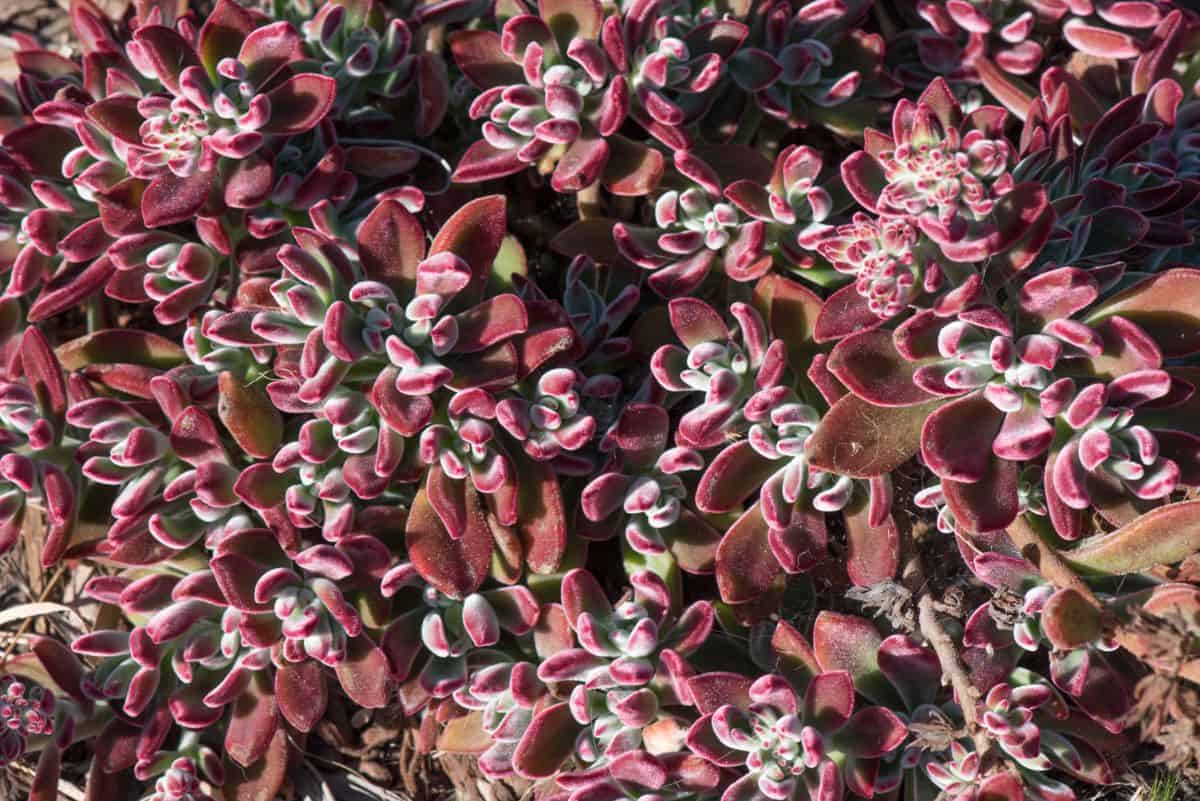
Jump to:
Echeveria harmsii Appearance
| Name: | Echeveria harmsii |
| Soil: | Well-drained soil |
| Blooming: | Spring |
| Light: | Bright, indirect light |
| Water: | When the soil is completely dry |
| Propagation: | Cuttings. offsets and seeds |
Echeveria harmsii is a petite rosette-shaped succulent with light green leaves. The margins and tips of the plump, narrow leaves have a red hue that deepens with sun stress.
The leaves of Echeveria harmsii also have a soft velvet coating that gives this succulent a soft, velvety appearance. This is why the plant has been given the nickname Plush Plant.
At maturity, this succulent measures about 12 inches in diameter and about the same in height. Each leaf measures just over an inch long.
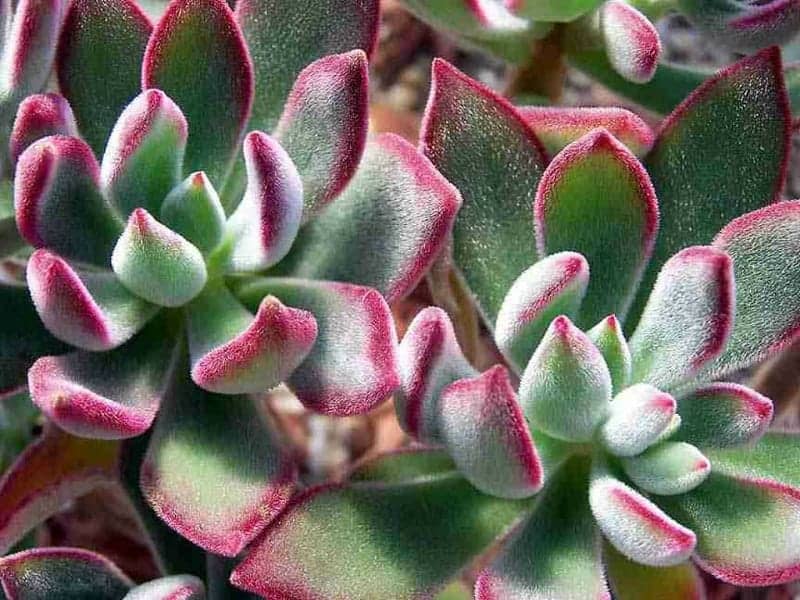
Buy it from:
In the spring, E. harmsii blooms and produces a slender stalk up to 4 inches in length. Atop that stalk are bright red, bell-shaped flowers with yellow tips.
Caring for Echeveria harmsii
Like most Echeveria, this is not a difficult succulent to care for. They are non-toxic to both pets and humans, so you can grow them in a household with children or furry family members without worry.
Light
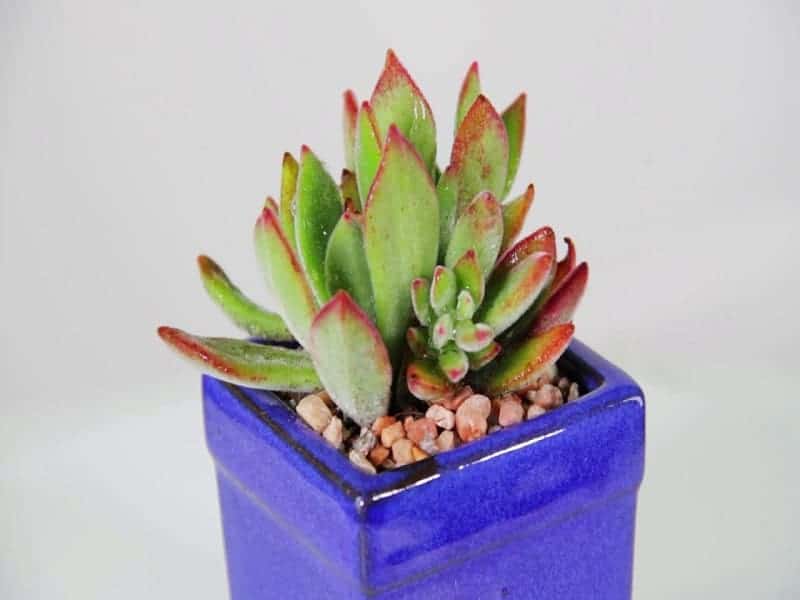
Echeveria harmsii require bright, indirect light when grown indoors. Too little light will result in etiolation, or stretching out. While this certainly won’t harm the plant, many gardeners find it unsightly. To avoid etiolation, it’s important to give your Echeveria enough light.
No products found.
If adequate indoor light is not available, artificial light may be provided with a grow light. Grow lights are ideal for growing succulents like E. harmsii in low light environments.
Too much direct sunlight should also be avoided as it could result in sunburn. As with etiolation, a little sunburn is mostly cosmetic, but prolonged periods in direct sunlight could kill the plant.
If you’re growing Echeveria harmsii outdoors, be sure to plant it where it can be protected from the afternoon sun, especially during the heat of summer.
Drastic changes in light should also be avoided to prevent sunburning your Echeveria. If you need to increase your succulent’s light levels, be sure to do so slowly over a period of several weeks to allow your plant to acclimate.
Water
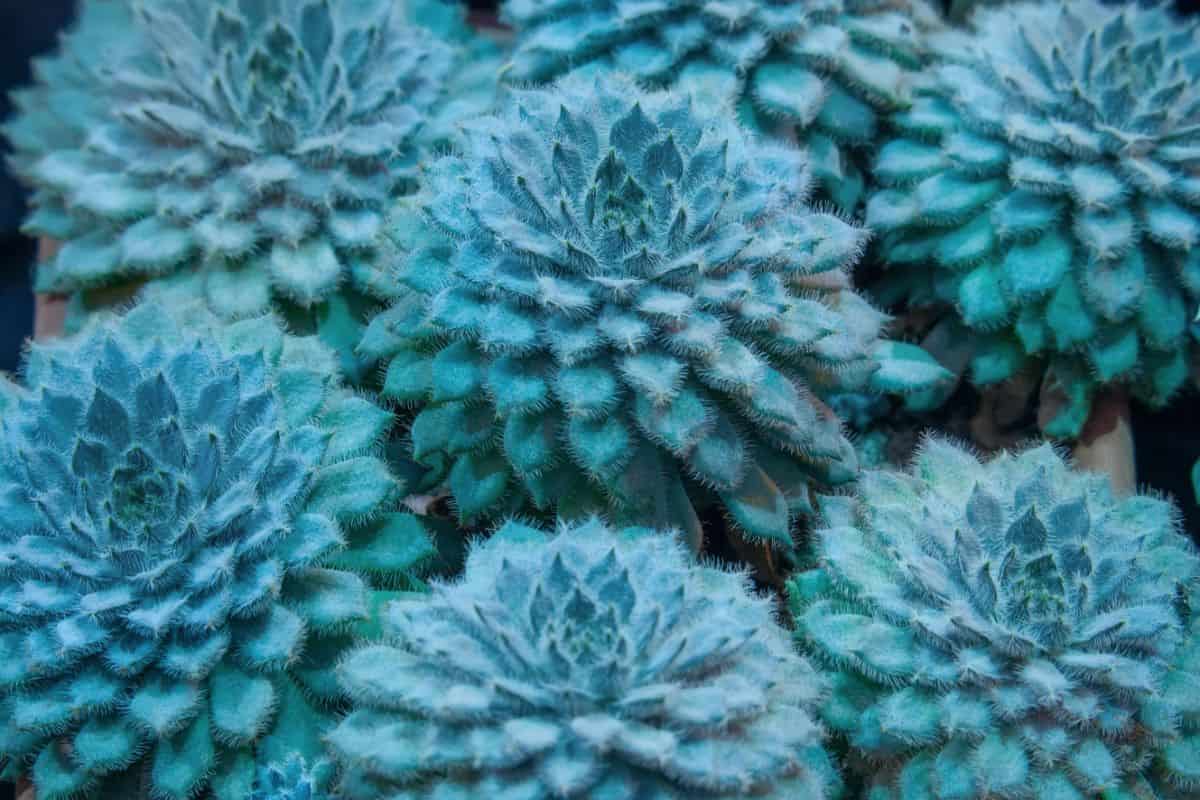
As with any other succulent, standing water and overly wet soil should be avoided at all costs. Echeveria harmsii is not a fan of long droughts either, so it’s important to find the right middle ground.
The best method for watering E. harmsii is to water the plant deeply but allow the soil to dry out before watering again. This can be accomplished by checking the soil each and every time you water to make sure the soil is dry enough.
To test the soil moisture, use a soil moisture meter or your finger. Insert your tool of choice into the soil a few inches. If the soil is still moist, wait a few days and try again. If the soil is dry, it’s time to water.
Temperature
Echeveria harmsii is not a particularly cold tolerant succulent. Though a light frost likely won’t harm the plant, consistent temperatures below 30 degrees Fahrenheit can spell trouble.
If you grow your succulents outdoors, you may need to bring them inside during frigid weather or take measures to protect them outdoors.
Echeveria grown indoors don’t usually have any problems with extreme temperatures, but sudden drafts should be avoided if possible.
Soil
As with most succulents, Echeveria harmsii prefers well-draining soil with few water-retaining qualities. That means little to no peat moss or clay and plenty of coarse sand, gravel, perlite, or even bark.
A commercial soil formulated for cacti or succulents works well, or you can make your own. For more information regarding the ideal soil for succulents, read our guide here.
Choosing the right soil is great, but don’t forget about proper drainage with your container. E. harmsii does best in a pot with a drainage hole. Though it is possible to care for a succulent in a pot without a hole, you have to be much more precise with your watering.
Echeveria harmsii will grow fine without fertilizing, but they can benefit from the extra nutrients, especially if they’ve been in the same soil for a long time. Of course, repotting will also solve this problem.
Propagating Echeveria harmsii
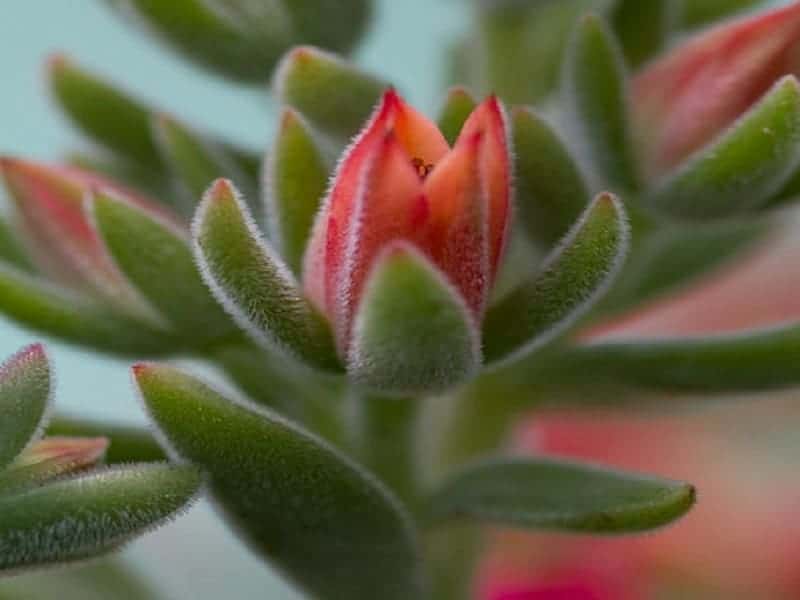
If you’re looking for an easy succulent to try propagation with, look no further than Echeveria harmsii. This adorable succulent is easy to propagate, no matter how much gardening experience you have.
There are three methods of E. harmsii propagation: offset separation, leaf or stem cuttings, and seeds. Each method has their benefits, but don’t be afraid to try something new.
Offsets
Offset separation is by far the easiest method of succulent propagation. It’s also the best choice for impatient succulent lovers as you’re essentially removing a tiny version of the mother plant. You don’t need to wait for it to look like Echeveria harmsii.
Offsets, or pups, can be removed by gently separating them from the mother plant with your fingers or a sharp, clean knife. Try to separate them as close to the mother plant as possible, giving your new plant as much of a root system to start with as possible.
Once separated, allow your offsets to dry for a few days to help their wounds callous. This prevents possible infection by fungus or bacteria through the open wound.
After your offsets have calloused, it’s time to plant. Simply plant them in Echeveria approved soil and treat them as you would a mature succulent.
Cuttings
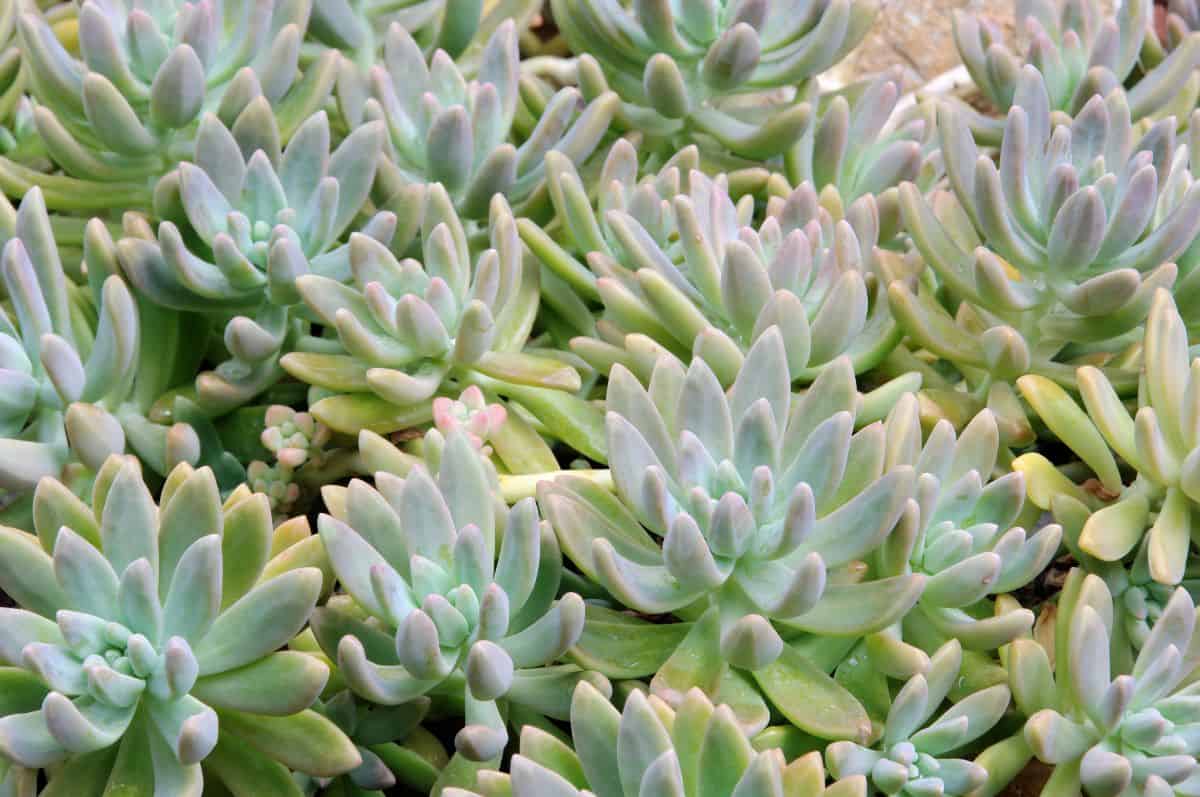
Another popular way to propagate E. harmsii is with leaf or stem cuttings. Cuttings take a bit longer than offsets, but not as long as seeds so they’re a great in-between method for most gardeners.
Stem cuttings can be taken by simply snipping off the top of the rosette. This is also a great way to recover an etiolated plant if you need to. Just be sure to use sharp, clean shears or scissors to make your cut.
You can collect leaf cuttings by using a sharp clean knife or shears to snip off a few leaves around the base of your Echeveria. Cut as close to the stem as possible without accidentally cutting the stem itself.
After you’ve collected your cuttings, let them dry out for a few days to callous, just as you would with offsets.
Unlike offsets, your cuttings need to root before they can really start growing. You can use rooting hormone to speed this process up if you’d like, but this isn’t necessary.
Then, set your cuttings on moist, well-draining soil and keep them out of direct sunlight. Soon you’ll start seeing roots and a tiny rosette.
Seeds
Growing any succulent from seed is a venture only for the most patient gardeners. Echeveria harmsii aren’t fast growing plants, so it can take a while to get a mature plant from seeds. Succulent seeds can be collected from your other E. harmsii, or you can buy them online.
To propagate your succulent from seeds, sow them in moist soil. Remember to use well-draining soil to prevent your succulents from rotting. You’ll want to keep the soil moist, but not wet, and in a warm, bright area.
After a few weeks, you should begin to see tiny succulents sprouting from the soil. Allow the Echeveria seedlings to grow to a sturdy size before attempting to transplant them to their own containers.
Sources:
“Care of Non-Hardy Cacti and Succulents.” Cornell University.
“Echeveria harmsii” The National Gardening Association Plants Database.


